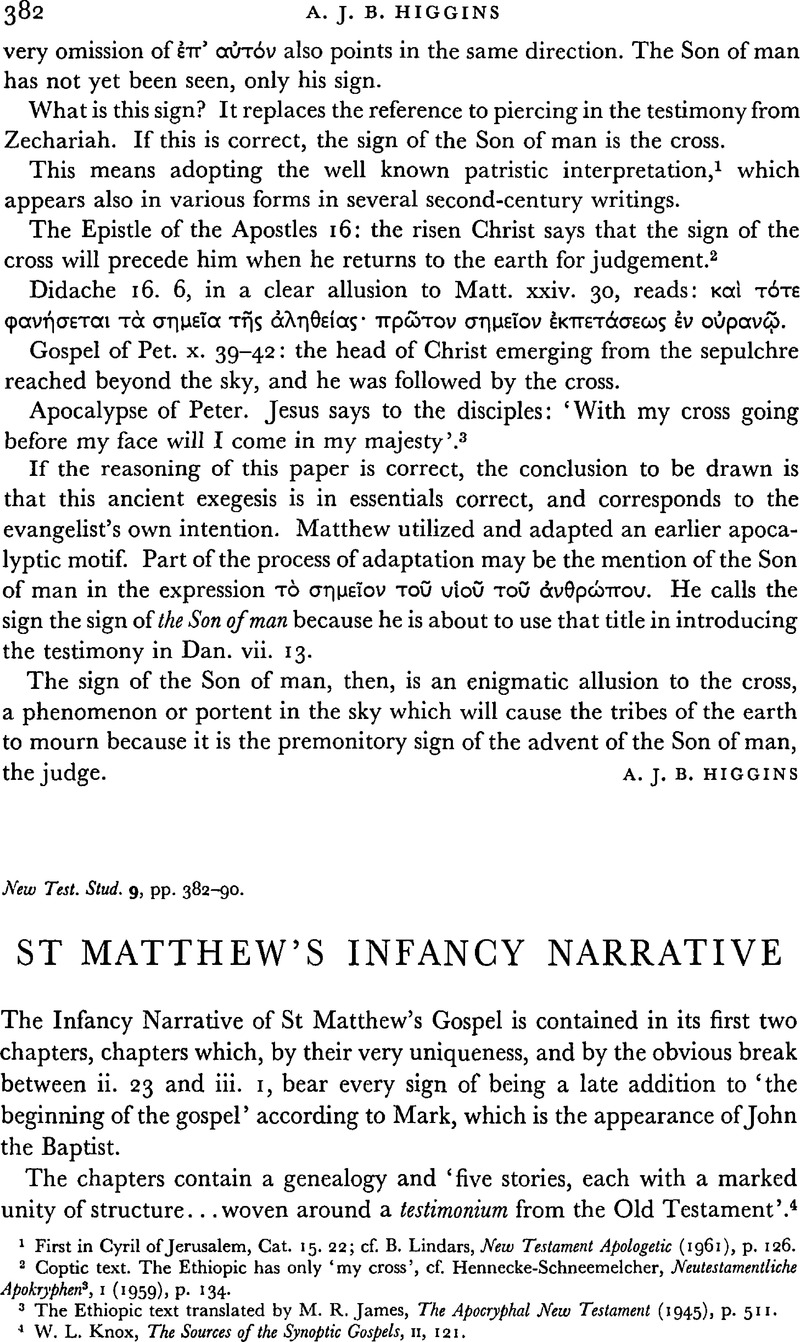Article contents
St Matthew's Infancy Narrative
Published online by Cambridge University Press: 05 February 2009
Abstract

- Type
- Short Studies
- Information
- Copyright
- Copyright © Cambridge University Press 1963
References
page 382 note 1 First in Cyril of Jerusalem, Cat. 15. 22; cf. Lindars, B., New Testament Apologetic (1961), p. 126.Google Scholar
page 382 note 2 Coptic text. The Ethiopic has only ‘my cross’, cf. Hennecke-Schneemelcher, Neutestamentliche Apokryphen3, 1 (1959), p. 134.Google Scholar
page 382 note 3 The Ethiopic text translated by James, M. R., The Apocryphal New Testament (1945), p. 511.Google Scholar
page 382 note 4 Knox, W. L., The Sources of the Synoptic Gospels, ii, 121.Google Scholar
page 383 note 1 Richardson, A., An Introduction to the Theology of the New Testament, p. 171, compare B. W. Bacon, Studies in Matthew, pp. 148 ff.Google Scholar
page 383 note 2 Book of Common Prayer.
page 383 note 3 Stauffer, E., Christ and the Caesars, p. 13.Google Scholar
page 383 note 4 Daube, D., The New Testament and Rabbinic Judaism, pp. 158 ff.Google Scholar
page 383 note 5 Daube, D., op. cit. p. 188.Google Scholar
page 383 note 6 Daube, D., op. cit. p. 190.Google Scholar
page 383 note 7 Daube, D., op. cit. p. 281.Google Scholar
page 383 note 8 Davies, W. D., Paul and Rabbinic Judaism, p. 104.Google Scholar
page 383 note 9 Daube, D., N.T.S. v (1958/1959), 174–87, esp. p. 176, n. 1.Google Scholar
page 383 note 10 Stein, S., ‘The Influence of the Symposia Literature on the Literary Form of the Pesah Haggadah’, J.J.S. viii (1957), 13–44.Google Scholar
page 384 note 1 W. L. Knox, op. cit. p. 122.
page 384 note 2 Knox, W. L., op. cit. p. 122; G. D. Kilpatrick, The Origins of the Gospel according to St Matthew, p. 53.Google Scholar
page 384 note 3 A. Richardson, op. cit. p. 172.
page 384 note 4 See further Daube, D., New Testament and Rabbinic Judaism, p. 6.Google Scholar
page 385 note 1 See Mann, J., The Bible as Read and Preached in the Old Synagogue, p. 404.Google Scholar
page 385 note 2 A. Richardson, op. cit. p. 173.
page 385 note 3 Op. cit. pp. 122 f.
page 385 note 4 A later Haphtarah is Isa. i. 4 ff., but this has no connexion with our story.
page 385 note 5 DrGuilding, A., 1 The Fourth Gospel and Jewish Worship, pp. 101 f. suggests another lectionary setting, perhaps following the hint in Herford's Christianity in Talmud and Midrash, p. 255, but I do not think it can be developedGoogle Scholar
page 386 note 1 Plummer, A., Exegetical Commentary on St Matthew, p. 13.Google Scholar
page 386 note 2 See and compare Dam. Doc. vii. 19; T. Levi xviii. 3; Rev. xxii. 16.
page 386 note 3 Stendahl, K., The School of St Matthew, p. 136.Google Scholar
page 386 note 4 Swete, H. B., Introduction to the Old Testament in Greek, p. 338; compare B. W. Bacon, Studies in Matthew, p. 471.Google Scholar
page 386 note 5 Op. cit. p. 190.
page 386 note 6 Targ. Onk. locates Pethor in Aram, a fact that shows acquaintance with popular tradition, but forbids the identification of ‘the River’ with the Euphrates.
page 387 note 1 This is the implication of Mal. iii. 5, 6.
page 387 note 2 For myrrh compare Exod. xxx. 23.
page 387 note 3 Can this be why Matthew speaks of a house in ii. 11?
page 388 note 1 E.g. Montefiore, Synoptic Gospels, 11, 458, ‘Many heroes have troubled childhoods, e.g. Moses, Cyrus, and several others’.
page 388 note 2 Reading ![]() for
for ![]()
page 388 note 3 The same assumption is familiar to St Paul (Rom. v-vii; I Cor. x. 1 ff.; xv. 20), and to the author of Hebrews (vii. 9 f.).
page 388 note 4 By this I do not mean that ‘Son of God’ was a title of the Messiah (see Cullmann, Christology of the N.T. pp. 273 f.), but that Exod. iv. 22; Ps. ii; Hos. xi. 1 were interpreted of the Messiah.
page 388 note 5 Jos. B. J. 1, 660.
page 388 note 6 A. H. M'Neile, Gospel according to St Matthew, in loc.
page 388 note 7 Stendahl, op. cit. p. 197.
page 389 note 1 Daube, op. cit. p. 191.
page 389 note 2 Hertz, J. H., The Pentateuch and Haftorahs, 11, 142.Google Scholar
page 389 note 3 Aggadath Bereshith to Gen. xxxv. 19, compare Lam. R. 25.
page 389 note 4 Stendahl, op. cit. p. 199.
page 389 note 5 Peake, A. S. (ed.), The People and the Book, p. 440.Google Scholar
page 390 note 1 Op. cit. p. 121.
page 390 note 2 Op. cit. p. 471.
page 390 note 3 Op. cit. pp. 103 f.; 198 f.
page 390 note 4 Black, M., An Aramaic Approach to the Gospels and Acts, pp. 143 ff.Google Scholar
page 390 note 5 Black, M., The Scrolls and Christian Origins p. 83.Google Scholar
page 390 note 6 Compare Luke i. 35.
page 390 note 7 Black, M., The Scrolls and Christian Origins, p. 83, and compare ‘The Patristic Accounts of Jewish Sectarianism’, B.J.R.L. xli (1959), 299 f.Google Scholar
- 1
- Cited by


